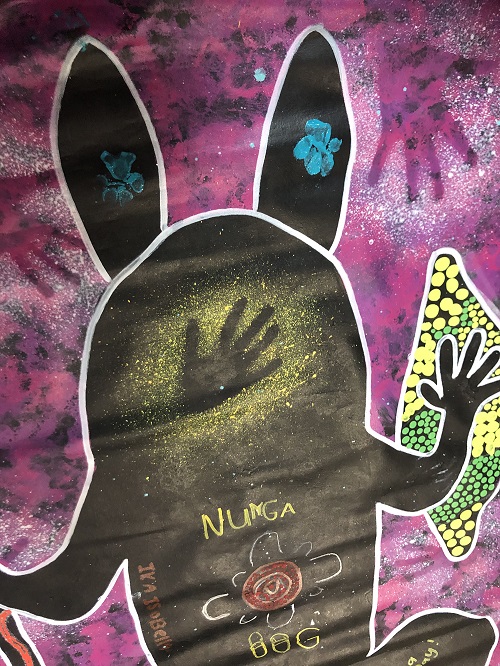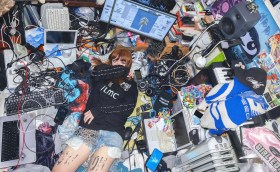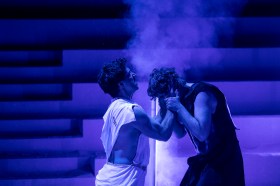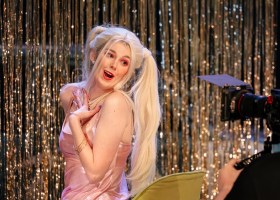In my first week running Riverland Youth Theatre, I am almost manic with ideas and new information. Notes are jotted on pieces of paper, plans sketched on calendars, and conversations notated in Word documents with helpful names like ‘Document5’ or emailed to myself with titles like ‘DO THIS WEDNESDAY’. To record and cherish the most important things, I start a document: ‘First and Best Lessons’.
Lesson One
The first time I see a child in our office, she looks bored. I watch as her eyes scan our ordered space without interest until they land on one of the only playful objects in it: a yellow and orange camel made of Styrofoam. That is when she reaches for the hand of the tall man beside her and tugs. Wordlessly she points to the camel, and I see her relax.
Kids will look for signs that they are welcome in a space. We need to move the office so that the first thing they see when they walk through our door isn’t a desk but an invitation to play and to collaborate.
Lesson Two
The second child I meet I’ll call ‘Tom’. He is a First Nations kid in care, here in our building for a workshop called Nunga OOG, ran by the Office of the Guardian for Children and Young People; kids around the state are coming together to create images of child safety.
Tom is hilarious. I laugh at his jokes.
‘What’s so funny?’ Tom asks.
‘You are. You’re a comedian,’ I tell him. ‘Should we do a comedy workshop here?’
Tom shrugs. All the kids in the session are passive when I suggest future activities.
Many kids in care can’t turn to a parent or carer and say, ‘Can we come back for x workshop?’ They have learnt not to plan or anticipate. To get them through the door, sadly, I must swim through bureaucracy and find funding to have carers bring them.
Lesson Three
Another child in the workshop spots my dog, Betty, waiting in the car and asks if she can come in. Betty joins us and wanders around under the table, pressing her nose into the kids’ outstretched hands and accepted offered Burger Rings and pizza crusts. The space instantly feels a little less like a giant hall and a bit more like a home.

Our painting is a collage of images that make the children feel safe.
‘Dogs make me feel safe,’ says the girl who spotted Betty in the car. “Can we put her paw prints on the painting?’
She gently paints Betty’s front paws. I pick my patient, rainbow dog up and place her on the painting. Her paw prints make us both laugh. Betty looks around for more Burger Rings.
Sometimes, a dog is the magic ingredient you need in a workshop.
Lesson Four
I start calling friends in the theatre community and asking: ‘What advice do you have for building a community?’
Katrina Cornwell and Morgan Rose from Riot Stage Youth Theatre tell me that the magic ingredient is friendship:
‘Friendship is what keeps the young people coming back every week. They are creating their own community and that happens in the break, when they arrive early or when you say, “You have 15 minutes to make…” Friendships happen when your back is turned.’
I walk around the building and remove ‘staff only’ signs. We move our desks around the corner and behind a pillar so we’re out of sight. I bring armchairs in from home and do a call out for second-hand toys and children’s.
Make a space for the kids who arrive early or stay late: a space for friendships to grow.
Lesson Five
Logan, my co-worker’s son, bursts into our office after school on Monday and instantly begins to climb on the couch.
‘I’m glad you’re here,’ I tell him. ‘I need your help because you’re an expert on being eight but I’m only an expert on being 34. What do eight-year-olds like?’
‘PlayStation,’ he tells me, now upside down. ‘Chewing gum. You should put lots of gum in here.’
‘You’re pretty good at climbing on that couch. You’d be great at an obstacle course.’
‘Could you build a climbing wall?’ he asks, crouched like a panther on the back of the sofa.
‘Not today but we could make an obstacle course and play Floor is Lava or we could build the biggest pillow fort this region has ever seen. What do you think?’
Logan writes the following list on the white board in our white office:
- Floor is Lava
- Pillow fort
- Obstacle course
For Logan, being eight means having a body ready to climb literal walls.
Lesson Six
I reach out to past Artistic Directors of the company. They all speak with such love of their time in the Riverland but Olivia Allen (AD 2010-2014) is to the point: ‘A lot of what I did might not be possible for you because the funding situation has changed so much.’
And it has. Youth Arts is no longer a separate category in Australia Council’s Company Funding and the whole sector has shuddered and contracted as a result.
When she had first arrived, it had been the company’s 25-year anniversary and so Olivia had started her tenure with a deep-dive into the history of the place.
‘It has been through everything,’ she says. ‘It has been through every high and low. I want to give you faith. RYT has always had ebbs and flows. The community and their love of the arts is so strong. It is amazing what is possible with just that.’
Be hopeful. Look for what I could do tomorrow with no funding. Look at that pile of craft materials. The costume cupboard. Look for the things I can teach at the drop of a hat.
Lesson Seven
At the end of my first week, I am talked out. There was the conversation that happened when I ducked into the café across the road and the women who ran it, recognising me, told me their plans for social initiatives and community engagement. There was the conversation over wine with the deputy mayor who lit up when I asked her what she loved about the community, telling me of the strength, grief, beauty and ‘permeated grit’ of the country and people. There was a conversation over tea and bird watching cards about building the self-esteem of children on the spectrum. There was planning the first Riverland Pride march with the young people at HeadSpace and there was planning a haunted maze for the Spooktacular with a primary school. There were teachers, councillors, parents and grandparents who called to say ‘welcome’ and to ask what we could do for their young people. So that is my biggest lesson from this first week:
This theatre company is so important to the Riverland community. Everyone wants us to succeed and wants wonderful, creative opportunities for the young people here. This is a tiny company with a big mission, but we have a community behind us. So let’s get to work and make good things happen.






